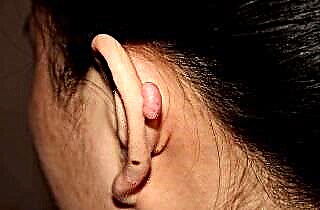It is quite difficult to meet a person who has never suffered from a cold. There are many reasons for rhinitis, so it is almost impossible to avoid its appearance. The course of the common cold has its own characteristics, which depend on the anatomy of the nasopharynx, the level of immunity and the type of provoking factor. How long does a runny nose last and can the duration of the illness be influenced?

Rhinitis goes through several stages:
- reflex, which is characterized by spasm of blood vessels, dryness of the nasal mucosa, burning, itching and frequent sneezing;
- catarrhal - differs in dilatation of blood vessels, swelling of the mucous membrane, as well as hyperemia of the nasal cavities. A mucous, watery discharge appears, the volume of which gradually increases. Nasal congestion makes it difficult to breathe and smell, and predisposes to nasal sounds. Also, a person is worried about insomnia, tearing and stuffy ears;
- the swelling of the mucous membrane gradually decreases, breathing is restored, the ability to distinguish aromas returns. The snot becomes thicker, shrinks and takes on a yellowish tint.
How many days a runny nose takes place depends on the strength of the provoking factor, human immunity and concomitant diseases of the ENT organs.
Infectious rhinitis
The duration of a viral rhinitis is 7-10 days.
The duration of the disease depends on the speed of response of the immune system to pathogenic pathogens. According to research data, it has been established that a sufficient level of antibodies in the blood is achieved on the 5th day of illness. This ensures a complete fight against viruses. A few more days are required to restore the affected tissues, which in combination is 7-9 days.
A runny nose in an adult can result from:
- hypothermia;
- inhalation of contaminated air;
- contact with sick people;
- the influence of an allergic factor;
 endocrine diseases associated with changes in hormonal levels. Often, rhinitis occurs in pregnant women, starting in the second trimester, and during adolescence;
endocrine diseases associated with changes in hormonal levels. Often, rhinitis occurs in pregnant women, starting in the second trimester, and during adolescence;- dysfunction of the nervous system, when the regulation of vascular tone is disturbed;
- abuse of vasoconstrictor drugs. They come in the form of a nasal spray or drops to combat nasal congestion. You also need to be careful to take medications to enhance male libido, antihypertensive and anti-inflammatory drugs;
- injuries, deviated septum;
- stay in the cold or in the sun;
- adenoids, chronic sinusitis;
- weakened immune defenses, severe infections or systemic diseases.
If bacterial pathogens become the cause of the common cold, the disease can persist for about a month. Often, bacteria join against the background of a viral infection and a weakened immune system. Signs of bacterial inflammation include:
- febrile hyperthermia, which decreases after the start of antibiotic therapy and washing the inflammatory focus with antiseptic solutions;
- thick greenish, foul-smelling discharge from the nose;
- nasal congestion;
- headache (area of the eyebrows, bridge of the nose, forehead, occiput, temples);
- nasal voice;
- insomnia;
- poor appetite;
- weakness.
When the infectious focus is limited only to the nasal mucosa, bacterial rhinitis can disappear within a week. If you start treatment with antibacterial agents on time, recovery can be brought closer. The duration of sinusitis, which has become a complication of a viral rhinitis, can be up to three weeks.
In chronic sinusitis, a runny nose is constantly observed, the differences are only in its severity.
It is difficult to cure a fungal infection, so the symptoms of a fungal rhinitis can be troubling for a long time with periodic deterioration and improvement in the general condition.
Vasomotor rhinitis
How many days does a runny nose caused by vasomotor rhinitis go away? Many of us use vasoconstrictor drugs when snot appears. They help to temporarily restore nasal breathing by narrowing the blood vessels, reducing swelling and secretion. It is important to know when to stop and not to abuse these medicines.
The fact is that the use of nasal sprays leads to a constant spasm of the blood vessels, therefore, in the future, the regulation of vascular tone is disrupted. The consequence of this is the lack of vascular response to the influence of exogenous or endogenous factors.
On the other hand, vasospasm leads to dryness of the mucous membrane, its increased trauma and the development of dependence. In some cases, it is enough to change the drug to achieve the desired effect. However, often vasoconstrictor drugs, even with an increase in the frequency and dosage of their use, cannot stop rhinorrhea and eliminate nasal congestion.
With vasomotor rhinitis, unilateral congestion is noted. This symptom is especially pronounced "lying". Lays the nasal passage on which you lie. Also, a person is worried about:
- increased nasal congestion when going out into the cold or nervous strain;
- runoff of mucus through the nasopharynx;
- sleep disturbance;
- headache.
What other factor can provoke vasomotor rhinitis?
- irritation of the mucous membrane occurs with dust particles or chemicals. This is especially often observed in people working in dusty rooms or in the paint and varnish industry;
- weather dependence. It is manifested by nasal congestion when humidity changes or in front of a strong wind;
- emotional stress;
- hormonal fluctuations associated with endocrine diseases;
- smoking, alcohol, spicy food.
Vasomotor rhinitis can go away in a day or be observed constantly. It all depends on the presence of contact with the provoking factor.
Allergic rhinitis
 When nasal congestion and rhinorrhea appear, you need to monitor how many days the runny nose lasts. This will help you contact a specialist in time and prevent unpleasant consequences.
When nasal congestion and rhinorrhea appear, you need to monitor how many days the runny nose lasts. This will help you contact a specialist in time and prevent unpleasant consequences.
If the snot does not go away for several weeks, and the examination of the otolaryngologist has ruled out the infectious nature of the disease, you need to look for allergens. In this case, an analysis of the level of immunoglobulins and an allergy test is required. This type of rhinitis is especially common in people prone to allergies.
An allergic reaction can be caused by:
- food products (chocolate, citrus fruits, seafood);
- dust;
- chemicals, including household chemicals, personal hygiene products;
- perfume aromas;
- fluff, pollen of plants;
- cigarette smoke;
- medicines.
A runny nose is called seasonal hay fever if symptoms occur during a specific period of the year. When the cause of the allergy affects a person all year round, then the allergy is constantly observed.
The intensity of the clinical signs can vary. They consist in the appearance:
- nasal discharge (watery, clear mucus);
- lacrimation of the eyes, redness of the conjunctiva;
- nasal congestion;
- frequent sneezing;
- cough.
The danger of constant contact with an allergen is the high risk of developing bronchial asthma. It is manifested by attacks of suffocation, severe shortness of breath and respiratory failure.
If the allergy is triggered by taking medications, the duration of the runny nose depends on the dose of the medication, the duration of the treatment course and the ability to accumulate it.
In addition, the process of elimination of the drug depends on the state of the internal organs (liver, kidneys). With organ dysfunction, medications are excreted for a long time, which is why their concentration in the blood decreases slowly, and the allergic reaction does not subside.
Snot in children
How long does a runny nose go through in children? In adults, snot passes 2-3 days faster in comparison with childhood. This is due to incompletely formed immunity in children and inadequate cleansing of the nasal cavities. In this regard, the child must be taught to "blow his nose", which will reduce the risk of infectious diseases.
There is also a physiological rhinitis in newborns, which is associated with the structural features of the respiratory organs. It can last up to two months and go away on its own.
In addition, nasal discharge of a mucous nature can appear against the background of teething, which does not require treatment. Rhinorrhea ends in 1-2 days in parallel with the abatement of the pain syndrome.
As for the allergic origin of snot, this is a big exception for babies. In older age, the frequency of allergies depends on the heredity and immune strength of the child.
Prophylaxis
To reduce the risk of snot, it is enough:
- refuse to communicate with animals, if there is a tendency to allergies to wool, use hypoallergenic cosmetics, get rid of indoor flowers, eat only those foods that do not cause an allergic reaction;
- regularly cleanse the nasal cavities from crusts;
- rinse the nose with saline solutions. They are sold in a pharmacy (Humer, Salin) or you can prepare them yourself (dissolve 5 g of salt in warm water with a volume of 230 ml). You can also use saline solution. Saline solutions are permitted for use from the neonatal period;
- breathe fresh air more often (in the evening in parks, botanical gardens, forest zone);
- drink enough liquid (1.5-2 liters daily);
- maintain a certain temperature and humidity in the house.

 endocrine diseases associated with changes in hormonal levels. Often, rhinitis occurs in pregnant women, starting in the second trimester, and during adolescence;
endocrine diseases associated with changes in hormonal levels. Often, rhinitis occurs in pregnant women, starting in the second trimester, and during adolescence;

